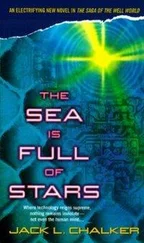Jack Chalker - Ghost of the Well of Souls
Здесь есть возможность читать онлайн «Jack Chalker - Ghost of the Well of Souls» весь текст электронной книги совершенно бесплатно (целиком полную версию без сокращений). В некоторых случаях можно слушать аудио, скачать через торрент в формате fb2 и присутствует краткое содержание. Год выпуска: 2000, ISBN: 2000, Издательство: Del Rey / Ballantine, Жанр: Фантастика и фэнтези, на английском языке. Описание произведения, (предисловие) а так же отзывы посетителей доступны на портале библиотеки ЛибКат.
- Название:Ghost of the Well of Souls
- Автор:
- Издательство:Del Rey / Ballantine
- Жанр:
- Год:2000
- ISBN:0-345-39485-2
- Рейтинг книги:4 / 5. Голосов: 1
-
Избранное:Добавить в избранное
- Отзывы:
-
Ваша оценка:
- 80
- 1
- 2
- 3
- 4
- 5
Ghost of the Well of Souls: краткое содержание, описание и аннотация
Предлагаем к чтению аннотацию, описание, краткое содержание или предисловие (зависит от того, что написал сам автор книги «Ghost of the Well of Souls»). Если вы не нашли необходимую информацию о книге — напишите в комментариях, мы постараемся отыскать её.
Ghost of the Well of Souls — читать онлайн бесплатно полную книгу (весь текст) целиком
Ниже представлен текст книги, разбитый по страницам. Система сохранения места последней прочитанной страницы, позволяет с удобством читать онлайн бесплатно книгу «Ghost of the Well of Souls», без необходимости каждый раз заново искать на чём Вы остановились. Поставьте закладку, и сможете в любой момент перейти на страницу, на которой закончили чтение.
Интервал:
Закладка:
“Urn—excuse me? Tube?”
“Yes. It does cost, and you’ll have to get your money changed, but it’s pretty reasonable. Fast, too. My company built this line decades ago.” She looked at the watch strapped to her wrist. “My goodness! Glad to have been of help, but I really must be going!”
“Oh, that’s all right. But this—tube…?”
The engineer was already heading away toward the hex boundary. “Don’t worry. You’ll see what I mean! Good fortune in your venture, whatever it is!”
They watched her go, once more alone and regretting it.
So, you want to see what she meant? Ari asked.
Might as well, Ming responded. Since we’re going that way anyway.
It may have been little more than a kilometer to Banu City, but it took them a couple of hours to get there while they got used to the vastly different and very alien environment and the new way to breathe. Compensating for the lower oxygen content was much like it would have been for high altitude work back in the Terran universe from which they’d come.
I wonder if it’s this hard for air breathers to cross a border up top? Ari mused.
I doubt it. Altitude and maybe temperature, but I doubt if there’s anyplace where the air is so filled with food that you die of gluttony by simply breathing normally, she replied.
Ain’t that the truth!
Still, they did make it to the city using the magnetic routing lines and the grids.
Banu City was actually only a small town by Yabban or any other standards, but it certainly was impressive nonetheless.
Impossible to ignore was the smell and taste of sulfurous compounds in the water. They stung the eyes and gills and any minor cuts or scrapes.
It was not a town either Ari or Ming would feel comfortable living in for other reasons entirely. Even in the murky water, it spread out before them in an alien design. Broad boulevards were clearly designed for a species that liked to walk rather than swim. Large but low buildings no more than four stories tall were designed by and for nothing vaguely hu-manoid. The town was lit in varying colors by what could only be some sort of chemical secretions, whether natural or artificial, that were mixed and matched for shade and brightness and applied where needed. The streets were clearly outlined in bright green lights, the buildings in varying reddish hues. The Yabbans were all over the place, crowding central squares and going in and out of building entrances with such speed and sense of purpose it reminded both of them less of a city—Terran or Kalindan—than of an insect colony.
Of greater interest were numerous long, thin transparent tubes. They went in and out of every building and crossed streets overhead. Things were routed inside the tubes at great speed as they went into and out of rooftop level enclosures. Since they were much too small to be the transportation tubes the Kalindan engineer had been referring to, it took several minutes and a much closer look before Ari and Ming realized what they were.
Some kind of high pressure piping! Ari noted, amazed, as he watched a Yabban at street level insert something into a small cylinder, open a branch tube, put it in, then use a claw to press a lever. There was a hiss and some bubbling and the small cylinder suddenly took off and joined the main route. As it passed the point of the lever, the yellow-painted bar shot back up on its own, closing off the start.
Wonder how it knows where it’s going? Ming mused.
Must be in those little houses up top. Somebody’s throwing switches, maybe based on color codes. We’ll never know, I suspect. Translators allow us to speak to these folks like natives and be understood the same way, but they don’t teach us how to read Yabban.
And, as they were learning, just because you heard somebody as if they were a native didn’t mean that you could understand what they said. Creatures like the Yabbo were quite alien to Kalindans.
Still, it wasn’t its incomprehensibility that made the town one they didn’t feel comfortable in, but rather what it was built upon and what lay just beyond it. It was an active volcano, and blotted out much of anything beyond to the south.
Much of the activity was coming off the sides of the mountain—smoking, hissing, and often exploding. It was unnerving, almost as unsettling as the fact that the town was built on a lava flow right up against that mountain.
You think they can predict when it’ll go off? Ming wondered.
Probably. I’d say these folks had to be experts if this is the way they live. Otherwise there wouldn’t be any Yabbans around by now. They must not hear like we do, though. Those explosions would not only keep you awake, they’d drive you batty.
In a layer of construction between the town and the volcanic activity there were large artificial works: towers, spirals, pyramids, and cubes. Much of it had the look and feel of Kalindan construction. Even through the murkiness they could see how large the industrial works were, and they could also see networks of cables going along the floor of the sea in all directions.
There’s the answer. Power, Ari noted. Natural steam power harnessed and directed through pressure regulators anywhere else they wanted. Pressure to run turbines or move heavy machinery or even generate electrical fields. The “rules” prevented batteries from working here, but apparently not transformers, as there were several large ones just at the edge of the town. They couldn’t store it, but they could use the steam power so long as the volcano and the molten magma beneath them remained active.
Ari and Ming decided to move around the city rather than through it, at least for now. There didn’t seem to be much reason to go there at the moment, and the noise was deafening.
I hope all the cities and towns aren’t like this, Ming commented. Otherwise we’ll have no hearing left by the time we get through this place.
Unfortunately, their helpful Kalindan friend had forgotten to tell them to get earplugs or sound dampers. On the east side, though, they did find the tube that their kinsman had spoken about—and it truly was obvious.
Just as the town seemed to be shipping small parcels, messages, and the like through a miniature steam-pressure-powered pneumatic tube system, there was another, similar system that was even more impressive because it was designed for people.
That is, for Yabbo’s people, anyway.
Although it drew power from the volcanic fields, it did so indirectly via the industrial works and transformers and whatever else was in those buildings. The giant tube appeared to them as a solid gigantic pipe when viewed through most of their senses, although their vision said it was the same sort of translucent material as the smaller parcel network. Clearly, a magnetic substance formed a thin coating inside the tubes. The “cars”—which looked more like oblong shaped pills— also had a coating, but of opposite polarity. When one was pushed by a pressurized rod into position to inject into the tube, it appeared to be just smaller all around than the tube. It hovered, not quite touching the sides. The craft was then in a condition that approximated weightlessness, and it didn’t take a lot of force to propel it along those tubes. The vehicle coating itself appeared inert; the tube coating seemed to get some power from a steam turbine. That was how it was controlled. Section by section they could apply power and therefore create an electromagnetic field, or remove power, at which point the vehicle would skid to a halt using friction and perhaps some sort of purely mechanical braking.
It was, in effect, a national train system for moving cargo and people, in a hex that was prevented from employing the highest technology and was also underwater. It was damned clever.
Читать дальшеИнтервал:
Закладка:
Похожие книги на «Ghost of the Well of Souls»
Представляем Вашему вниманию похожие книги на «Ghost of the Well of Souls» списком для выбора. Мы отобрали схожую по названию и смыслу литературу в надежде предоставить читателям больше вариантов отыскать новые, интересные, ещё непрочитанные произведения.
Обсуждение, отзывы о книге «Ghost of the Well of Souls» и просто собственные мнения читателей. Оставьте ваши комментарии, напишите, что Вы думаете о произведении, его смысле или главных героях. Укажите что конкретно понравилось, а что нет, и почему Вы так считаете.












